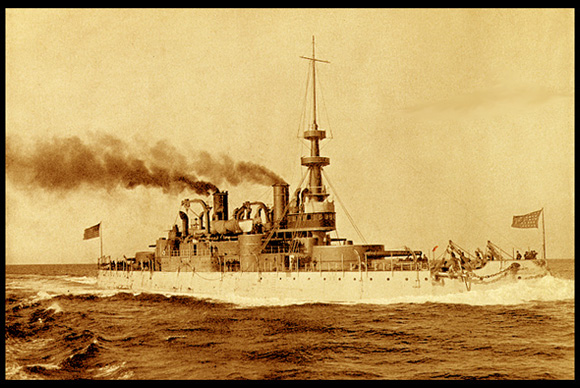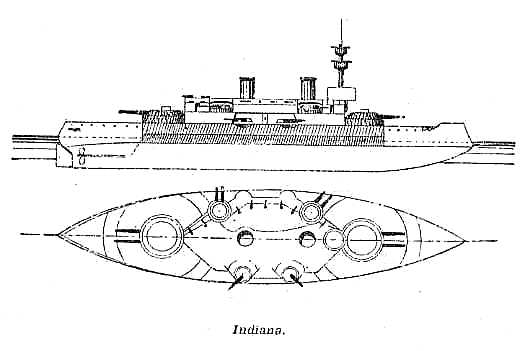


At the outbreak of the Spanish-American War, USS INDIANA formed part of Admiral Sampson's Squadron which sailed to intercept Admiral Cervera's squadron, known to be en route to the Caribbean from Spain. INDIANA took part in bombardment of San Juan on May 12, 1898. Sampson then returned to Key West and resumed the blockade of Havana. When it was confirmed that Cervera was at Santiago de Cuba, Sampson's fleet joined Schley there on June 1 and the Admiral took command of the blockade. After the landing of US Army units for an assault on Santiago, Cervera was ordered by Governor-General Blanco to break out of the harbor. His gallant dash out of Santiago on July 1898 led to the Battle of Santiago and the destruction of Cervera's entire command. INDIANA did not join in the initial chase westward because of her extreme eastern position on the blockade, but she was near the harbor entrance when the Spanish Torpedo Boat Destroyers PLUTON and FUROR emerged. In a short time both ships were destroyed by the guns of INDIANA and other ships. Meanwhile the other Spanish vessels were sunk or run ashore.
INDIANA returned to her peacetime pattern of training exercises and fleet maneuvers after the war, and made practice cruises for midshipmen of the Naval Academy before decommissioning in December, 1903. She was recommissioned for training in January, 1906, and again decommissioned in May, 1914. The entry of the United States led INDIANA to being recommissioned as a gun training ship on May 24, 1917. She was decommissioned for the last time on January 31, 1919. INDIANA was sunk as bombing target on November 1, 1920, and the wreck was sold for scrapping in March, 1924.
The armor thickness and size of the main battery exceeded any that on any other ship in the US fleet, including the newer classes of battleships.
One disadvantage of INDIANA and her sisters was a relativly low freeboard, which made the guns difficult to operate in heavy seas.
The main gun mountings were not centralized, so when the guns were aimed to the side, the ship would submerge farther on the side of the vessel to which the guns were aimed. This limited the elevation the guns could attain. Also, this resulted in the main armor belt being lower one side than designed and higher on the other when the guns were being aimed in this manner. The situation was eventaully rectified by adding counter-balances to the rear of the turrets. The mountings themselves continued to be a source of mechanical difficulty.
The ship rolled excessively until retrofitted with bilge keels.
As was typical for ships of this time period, coal bunkers were placed along the exterior hull of the ship to act as additional armor protecting the magazines. The proximity of the coal bunkers to the magazines created a danger that could result in the loss of the vessel. Spontaneous combustion of coal dust was not unusual, and a coal bunker fire could ignite an adjacent magazine.

| Classification: | Sea-Going Coast-Line Battleship, BB-1 | |
|---|---|---|
| Keel Laid: | May 7, 1891 | |
| Launched: | February 28, 1893 | |
| Comissioned: | November 20, 1895 | |
| Rig: | One military mast. | |
| Armament: | Four 13" barbette guns | |
| Eight 8" barbette guns | ||
| Four 6" guns | ||
| Twenty 6 pounders | ||
| Six 1 pounders | ||
| Two Colt Gatling Guns (for landing parties) | ||
| One 3" field piece (for landing parties) | ||
| Three Whitehead torpedo tubes | ||
| Contractor: | William Cramp & Sons, Philadelphia, PA. | |
| Length: | 348 feet | |
| Beam: | 69 feet 3 inches | |
| Mean draft: | 24 feet | |
| Max. draft fully loaded: | 27 feet, 1-3/4 inches | |
| Displacement: | 10,288 tons | |
| Complement: | 32 officers and 441 enlisted men. | |
| Engine type: | Vertical triple expansion engines with a 42 inch stroke, | |
| generating 11,111 hp. Twin screw. | ||
| Boiler type: | Four double-ended and two single ended cylindrical boilers. | |
| Speed: | 15.55 knots | |
| Coal bunker capacity: | 1,594 tons | |
| Endurance @ 10 knots: | 5,500 nautical miles | |
| Armor: | 18 inches on sides, 6 -17 inches on turrets |
Gardiner, Robert, Ed., "Conway's History of the Ship: Steam, Steel & Shellfire - The Steam Warship 1815-1905", London: Conway Maritime Press Ltd., 1992.
Naval History Department, Navy Department, "Dictionary of American Naval Fighting Ships", Washington DC: Government Printing Office, 1959.
Reynolds, Francis J. "The United States Navy", New York: P. F. Collier & Son, 1918

